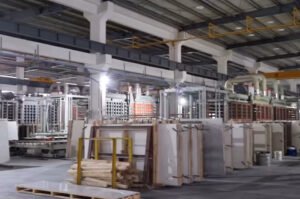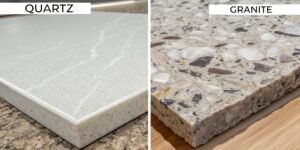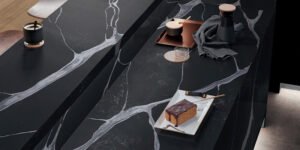Sourcing quartz slabs for large projects can be complex, with hidden costs from waste eroding your profit margins. A structured approach is essential for efficiency and cost control.
To minimize waste in the quartz slab supply chain, buyers must focus on four key areas: optimizing raw material composition, selecting efficient slab sizes like jumbo slabs, enforcing multi-stage quality control, and ensuring robust, transit-proof packaging to prevent breakage.

In this guide, as an Export Sales Manager, I'll walk you through the precise steps professionals take to streamline their supply chain. Following this process not only cuts down on physical waste but also saves significant time and money, ensuring your projects are both profitable and sustainable.
How can raw material selection impact waste?
Problem: Using low-grade quartz or inconsistent resin ratios.
Agitation: This leads to slabs with color variations, spots, or structural weakness, which are rejected later.
Solution: Vet your supplier's raw material standards.
The most effective method is to partner with manufacturers who use high-purity natural quartz (over 90%) and high-performance resins. This combination, managed by automated systems, ensures slab-to-slab consistency and drastically reduces defects, which are the primary source of production waste.
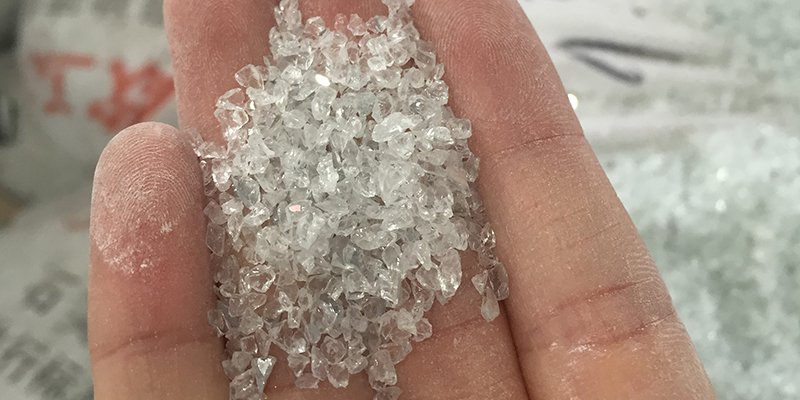
The foundation of a low-waste slab is what it’s made of. In the quartz industry, "waste" begins at the molecular level. Suppliers using impure quartz or cheap resins often produce slabs with higher porosity, inconsistent coloration, and a greater risk of cracking under fabrication stress. These defective slabs must be discarded, representing a total loss of materials, energy, and labor. Best practice demands sourcing from suppliers who can verify the purity of their quartz and the quality of their resin. A superior manufacturing process involves automated weighing and mixing systems that eliminate human error, ensuring every slab meets the exact same formulation. This precision minimizes off-spec batches that would otherwise be scrapped. At Opaly, our production is built on this principle; we use a minimum of 93% natural quartz, and our fully automated compounding system guarantees flawless material consistency, preventing waste before it's even created.
| Parameter | Industry Standard | Why It Matters for Waste Reduction |
|---|---|---|
| Quartz Purity | >90% Natural Quartz | Higher purity ensures better color clarity and structural integrity, reducing reject rates. |
| Resin Type | High-Performance Polyester | Quality resin prevents yellowing and provides superior strength, minimizing fabrication failures. |
| Mixing Process | Automated & Computer-Controlled | Prevents inconsistencies and off-spec batches that would otherwise become factory waste. |
| VOC Content | Low to Zero | High VOCs indicate inefficient curing and material loss to evaporation, a hidden form of waste. |
What role does slab size play in minimizing fabrication waste?
Problem: Standard-sized slabs often don't align with modern kitchen island or countertop dimensions.
Agitation: This results in significant, unusable offcuts for fabricators.
Solution: Prioritize suppliers offering jumbo sizes.
To reduce fabrication waste by up to 30%, procurement managers should specify jumbo-sized slabs (e.g., 3200x1600mm or larger). These larger formats allow fabricators to nest more parts and cover large areas like islands with a single piece, maximizing material yield.
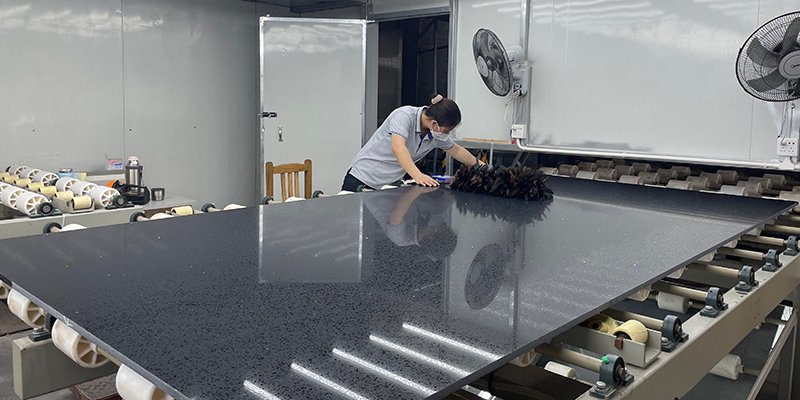
Once a slab reaches the fabricator, its dimensions directly determine the amount of waste generated. A standard slab (e.g., 3000x1400mm) may be insufficient for a large kitchen island, forcing the use of two slabs and creating an unsightly seam plus significant offcuts. This offcut material is pure waste, paid for by the client but ultimately discarded. The industry best practice is to analyze project layouts and order slab sizes that offer the highest yield. Jumbo slabs are the clear winner for most large-scale residential and commercial projects. They provide a larger canvas for nesting multiple countertop sections, vanity tops, and backsplashes, leaving far smaller and fewer offcuts. This not only reduces material disposal costs but also lowers the per-project slab requirement. We’ve found our partners achieve the highest efficiency with our jumbo slab offerings, which are specifically designed to maximize yield for modern design trends and drastically reduce offcut waste.
| Slab Type | Common Dimensions (mm) | Ideal Application | Waste Reduction Potential |
|---|---|---|---|
| Standard Slab | 3000 x 1400 | Smaller kitchens, vanities | Baseline |
| Jumbo Slab | 3200 x 1600 | Kitchen islands, large countertops | High (up to 30%) |
| Super Jumbo | 3500 x 2000 | Commercial projects, wall cladding | Maximum (up to 45%) |
How does stringent quality control prevent supply chain waste?
Problem: Receiving a container with cracked, warped, or discolored slabs.
Agitation: This halts projects, incurs replacement costs, and creates a massive disposal problem.
Solution: Demand multi-point QC reports before shipment.
A robust quality control (QC) system is non-negotiable. It must include documented inspections for dimensional accuracy (thickness, flatness), color consistency, and surface defects. This prevents defective products—pure waste—from ever entering the logistics chain.
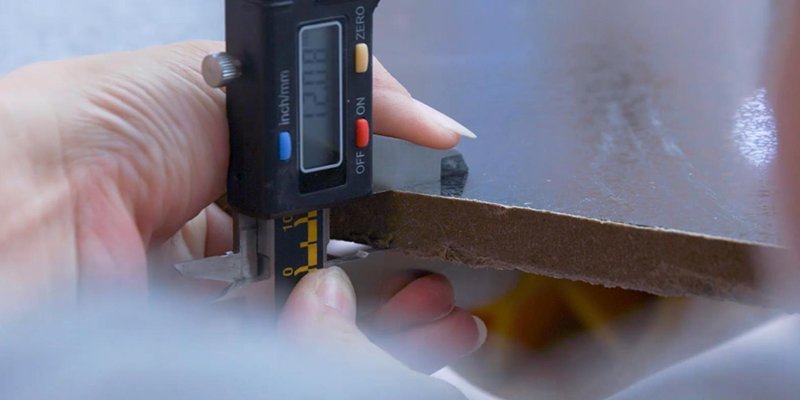
A slab that is rejected upon arrival is the most expensive kind of waste. It represents a 100% loss of the product cost, international shipping fees, import duties, and local transport costs. The only way to prevent this is to stop the defective slab from leaving the factory. Top-tier suppliers operate a multi-stage QC process. This includes checks after pressing, after curing, and a final, rigorous inspection before packing. Success is measured by having a clear, documented standard for every parameter—from thickness tolerance (e.g., ±0.5mm) to surface glossiness. Getting this wrong means an entire container could be compromised, leading to costly disputes and project delays. High-resolution photos and detailed QC reports should be a standard part of your shipping documents. At Opaly, we provide a comprehensive QC report for every container, including images and measurements, which is why our documented rate for defective slabs upon arrival is less than 0.1%.
| QC Check | Standard Method | Acceptable Tolerance | Impact of Failure |
|---|---|---|---|
| Thickness Uniformity | Digital Caliper | ±0.5mm | Uneven surfaces, difficult installation. |
| Color Consistency | Spectrophotometer & Visual | Delta E < 1.0 vs. Master | Mismatched slabs, rejected projects. |
| Surface Inspection | High-Intensity Light Box | Zero pits, cracks, or stains | Aesthetic failure, structural weakness. |
| Slab Flatness | Straight Edge Ruler | Max < 2mm deviation over 3m | Warped slabs, impossible to fabricate. |
Why is smart packaging critical for waste reduction?
Problem: Slabs arrive chipped or broken after a long sea journey.
Agitation: This is a total loss, causing immediate inventory shortages and reordering headaches.
Solution: Insist on internationally certified, robust packaging.
To eliminate transit waste, slabs must be packed in sturdy, fumigated wooden A-frame crates. Each slab should be separated by cushioning material, with edges and corners protected. The entire bundle must be securely strapped and wrapped in plastic film to prevent shifting and moisture damage.
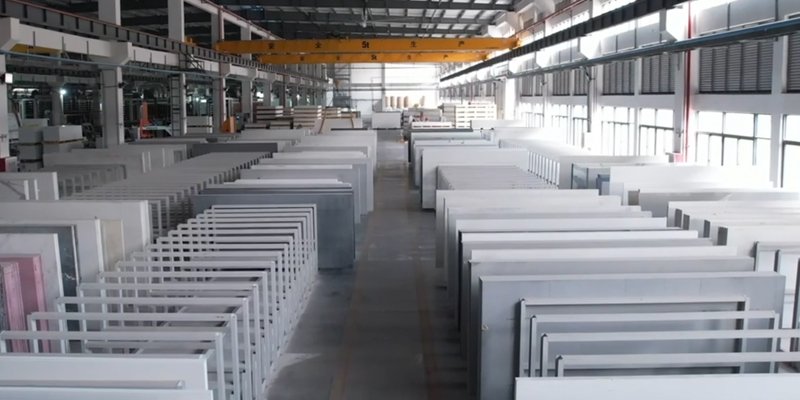
The final, and often most overlooked, point of failure is logistics. A perfect slab can become 100% waste in the final mile if not packaged correctly. The vibrations, impacts, and humidity changes during international sea freight are unforgiving. The industry standard is solid wood A-frame crates, which provide the best structural support. However, best practice goes further. It involves placing protective foam or cork pads between slabs to absorb shock, adding reinforced corner protectors, and shrink-wrapping the entire bundle to shield it from moisture, which can cause staining. A supplier's breakage rate is a key performance indicator of their packaging quality. A rate above 1% is unacceptable and points to systemic issues. Skipping this diligence means you are gambling with every shipment. Opaly’s packaging protocol was co-designed with logistics experts, leading to an independently verified transit breakage rate of under 0.5%, ensuring our clients receive what they ordered intact.
| Packaging Component | Standard Material | Primary Function |
|---|---|---|
| Crate Structure | Fumigated Solid Wood A-Frame | Provides rigid support against bending and impact. |
| Slab Separation | Foam/Cork Pads | Cushions slabs from each other to prevent scratches and shock damage. |
| Edge Protection | Hard Plastic/Rubber Guards | Protects the most vulnerable parts (corners and edges) from chipping. |
| Outer Wrapping | Heavy-Duty Plastic Film | Secures the bundle and protects it from moisture and dust. |
Conclusion
Following this structured process for materials, sizing, QC, and packaging transforms your supply chain from a source of risk into a competitive, low-waste advantage that Opaly delivers.


